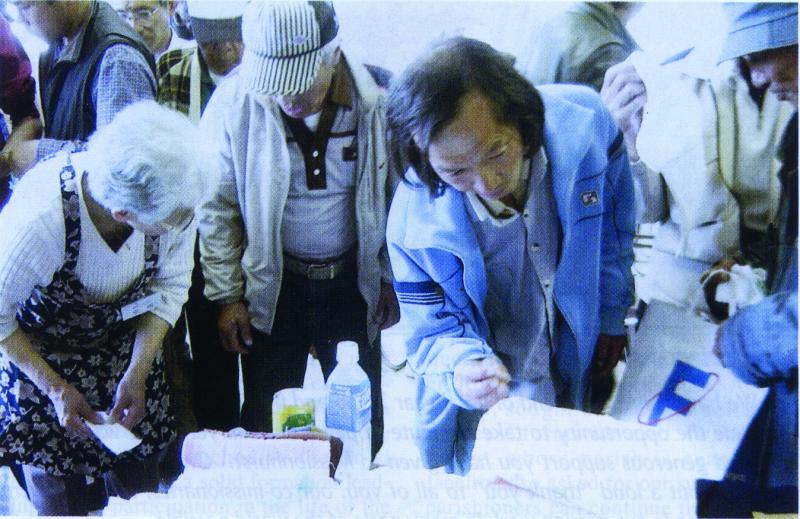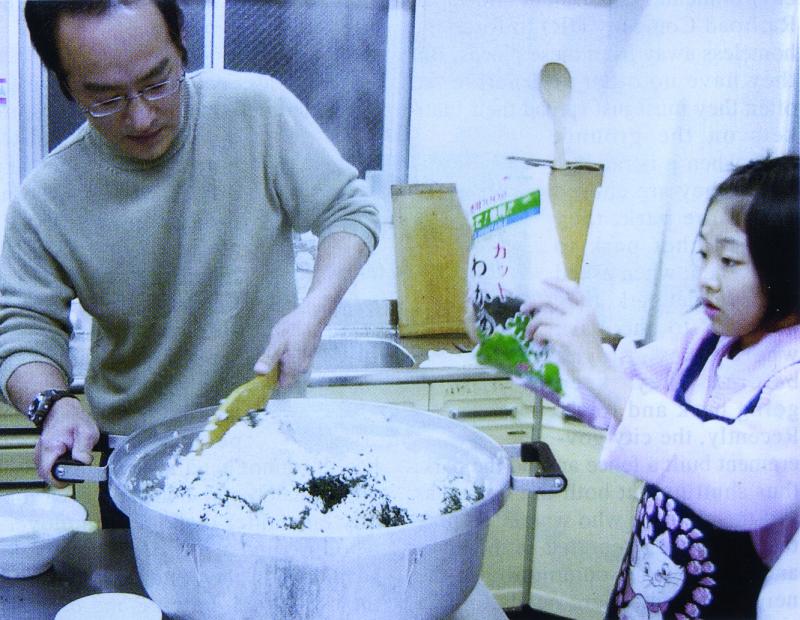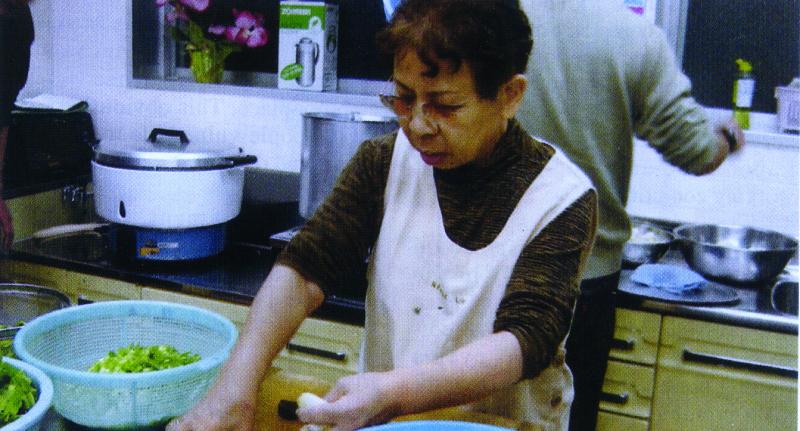Coming To The Light
By Father Garry Gestoveo
Father Garry Gestoveo, from Victorias City, Negros Occidental, joined the CICMs in 1990 and was sent to Japan in 2000. Ordained in 2004, he is the assistant parish priest of Fukuyama Church in the Diocese of Hiroshima, Japan.

Volunteers hold a distribution of towels
and clothing for the winter season
The evening that I arrived in my newly assigned parish of Fukuyama Church, Diocese of Hiroshima, I met Sister Marie Lisa of the Sisters of Mary Auxiliary. She was in the kitchen of the church along with a number of other people. They were preparing o-nigiri (rice balls) and miso-shiru (miso soup). I was new to the church, so I just assumed they were all parishioners of the church. They were so friendly, welcoming and warm to me. Only later when Sister Marie Lisa talked to me about the nature of their activity did I learn that they were volunteers comprised of many different faiths and backgrounds. They were engaged in preparing a dinner for the homeless in the area.
Tomoshibi Kai

Father and daughter team up in kind service to the homeless
The volunteers I met that first night were members of the Fukuyama Church Welfare Group, and they had taken the name Tomoshibi Kai. Tomoshibi, in Japanese, means light, or lamp. The group is made up mostly of volunteers from the YMCA school of social service department, certified social workers, volunteers from the City’s Public Assistance Committee, a few Catholics from the parish and a volunteer from the Himawari (Sunflower) Kai that belongs to the Protestant Church. Tomoshibi Kai was formed twelve years ago in Fukuyama Church as a social welfare committee that responds to needs of the homeless in the area.
In giving me some background on the group, Sister Marie Lisa told me that from 1990-2000 she dealt with twenty to twenty-five homeless people. But their numbers have increased and presently, there are about sixty people, including eleven women. Until 2002, the majority of the homeless had been middle-aged males. In 2003, volunteers’ ages ranged from 19 to 70 years old. This range in age is a national phenomenon. The increase in numbers is considered to be due to a rise in unemployment and bankruptcy, a decline in job opportunities and the break-up of families.
Plight of the homeless
The homeless people here, like elsewhere, can be found in the parks, at riversides, bus stops, underground passages, bicycle ports and railroad bridges. In the morning, some go to the train station that opens at 4am and they stay there until it closes at 10pm; then they need to look for a place to sleep again. Complaints from the people of the neighborhood lead the city’s environmental department and Japan Railroad Company (JR) to force the homeless away from these places. But they have no other alternative, so often they just spread their blankets on the ground, even when it is raining. When they are chased out of the park, they find another park to stay in. Then when asked to leave that park, they go back to the park where they stayed before. They keep going back and forth. Recently, the city government built a fence around the park, thus shutting out both the homeless and the children who wanted to play there. This was reported in the news and caused some commotion in the neighborhood. There needs to be a balance. The homeless have to reconsider the manner in which they use the public facilities, and the neighborhood has to understand the needs of the homeless.
The homeless’ situation
Homeless people encounter a lot of difficulties. It is difficult to secure a job through public employment security offices, where most candidates have a proper address and health insurance. As most of the work that is available requires physical strength, (shipyard labor, for example, where the workload is heavy), a 55-year-old person of marginal health cannot handle such a job. And unfortunately, the homeless occasionally encounter dishonest employers who hire under practices that take advantage of their situation: charging them for food, lodging and bathing, which leaves them with no earnings at the end of the contract. Some are even hired to do construction work and when the job is complete, they are chased off without receiving any pay. It is very difficult for the Department of Labor to do anything about these working conditions.

Sr Marie Lisa preparing the bowls for food distribution
Some of the homeless used to go around the city very early in the morning to find empty beer – and juice – cans, selling them to shops that collect aluminum. But even that is a waning option since the city government prohibited individual collection of cans and newspapers. They would get 700 yen (less than P300) for 10 kilograms of cans. It takes days to collect that many cans, so with one rice ball costing about P50, you can see that the reward for their effort is minimal.
With most homeless living without regular income or no income at all, picking up food thrown out by restaurants or convenience stores is commonplace. This obviously makes these people vulnerable to many illnesses and diseases.
The government, through its Livelihood Protection Office, grants financial aid to the needy especially to those who are sick. Yet, in order to be eligible, they must have a proper address and a letter from the doctor to prove that they are in need of money for medical purposes. A guarantor is often required to secure an apartment, but most families of the homeless refuse to serve as one. The volunteers of Tomoshibi Kai try to find shelter for the sick, but inexpensive apartments are hard to come by.
Ray of hope
One spot of hope has emerged though: The Livelihood Protection Office held some meetings with the volunteers of Tomoshibi Kai, in order to exchange opinions regarding the situation of the homeless. Subsequently, some of the officers participated in the nightly distribution of rice and soup to find out more closely about their actual living conditions. A doctor who conducts free medical check-ups for the homeless in Tokyo lent his experience in one of the seminars aimed at building positive attitudes towards the homeless.
For my part, after talking with my parish priest, I decided to join the volunteers in cooking and distributing the soup and rice on Sunday evenings. This kind of work opens a lot of possibilities for contact not only with the homeless, but also with people of this church and of the area where I live. I enjoy the company of the volunteers, who are very dedicated to their mission. Indeed, as the name of the groups suggests, they are bringing light to people who are neglected in society. At the same time, they bring light to people who have closed their hearts to the homeless. Although there are only a few parishioners who join the cooking and distribution, many make an effort to share contributions of rice to the Tomoshibi Kai. We have put up a box to collect funds for the food for Sunday distribution. Though our response seems small compared to the enormous needs, I am very hopeful that more people will come to the light, and begin to open their hearts to the homeless.
You may email Father Garry at gani2003@hotmail.comor write him at: Fukuyama Church, Shôwa-chô 7-26, FUKUYAMA 720-0208, JAPAN
